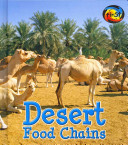2018 School Spending Survey Report
Desert Food Chains
9781484605219.
ea vol: 32p. (Food Chains and Webs). further reading. glossary. index. photos. websites. Heinemann-Raintree. 2014. lib. ed. $26.65.
COPY ISBN
ALREADY A SUBSCRIBER? LOG IN
We are currently offering this content for free. Sign up now to activate your personal profile, where you can save articles for future viewing





Be the first reader to comment.
Comment Policy:
Comment should not be empty !!!